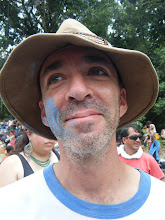The bullfights in Cali are held during the end of the year and coincide with their giant festival, Feria de Cali. We are here in Cali for the feria and going to a bullfight seems to be a thing to do. I have been before about 15 years ago in Spain, but Mika has never been so we decide to check it out.
 |
| Ticket windows at the Plaza del Toros |
By the time we get to the stadium we are late for the first of the six bullfights on the card for this afternoon. Like at the opera, we are not allowed to enter the arena while a match is in progress. We start talking with a guy who is also waiting to enter. He is a huge fan and has tickets for all eight days. We end up sitting with him. We are in the nosebleed seats but all around us are serious bullfight fans.
 |
| We'd be holding up the roof if there was one |
There are several steps which happen before the matador meets the bull face to face with his red cape, sword and really really tight pants. There are guys who wave large pink capes, there is a horse rider and two guys without capes that stick short spears into the bull. All of these are done so that the matador can study how this particular bull moves and reacts. When he is ready the matador stands alone with the bull. If he is performing well the Presidencia - judges presiding over the match - will signal a live band to play. The matador must kill the bull in a certain amount of time and he has three chances to do it. If it is not quick the crowd will whistle in disapproval. In the rare chance that the bull does not die, the beast is spared and the rest of his days will be spent out to pasture as a stud.
During the five matches we see just one is great. The matador is from Panama but studied here in Cali. He is ranked eighth in the world and earned US $6 million this year. By watching him dance with and manipulate the bull I really could begin to appreciate the sport. Even from our distance you can see how graceful he is. When it is over the crowd gives him a standing ovation while waving white handkerchiefs. A man in front of us lends Mika his extra one. The crowd's handkerchiefs are signaling the Presidencia to drop their white flag and honor the matador with the dead bull's ear. If they drop two flags he will get both ears. A third and final flag they'll chuck in the tail. At this match the matador is rewarded one bull's ear. Like a real superstar he tosses it into the crowd - though I am not sure who actually wants to catch it! After this display I can begin to understand why even today it has such a passionate following.
One other good thing about the bullfight is that it is BYOB -- bring your own bota. The bota is a leather sack (or plastic these days) which you fill up with your beverage of choice. Cold Manzanilla - a sweet red wine - is the traditional drink to bring. Sharing the bota with the people seated next to you is definitely a quick way to make friends at a Colombian bullfight. We buy our bota outside of the stadium and the seller fills it up for us exchanging our warm bottle for one of his cold ones.
 |
| Step 1: fill the bota |
 |
| Step 2 |
















No comments:
Post a Comment